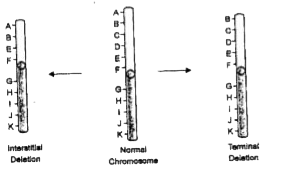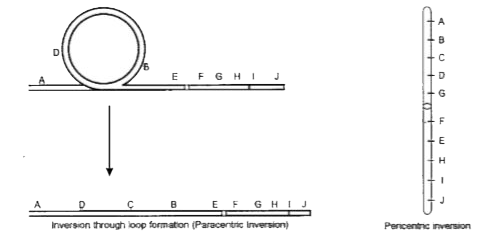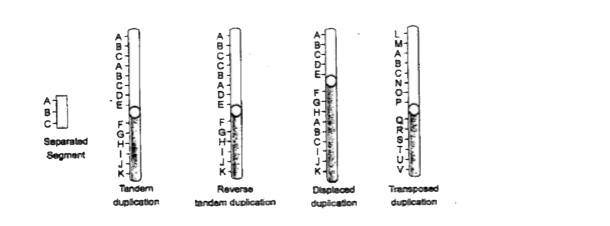Describe in detail chromosomal mutations.Solution in Punjabi
Chromosomal Aberrations (Chromosomal mutations). They are changes in the number and arrangement of genes in the chromosomes. Chromosomes some aberrations may involve changes in single chromosomes (mtrachromosomal aberrations) or two chromosomes interchromosomal aberrations). The aberrations are of several types. he important ones are as follows (i) Intrachromosomal Modifications. They are aberrations caused by breaking of chromosome segments and their loss or gain within a single chromosome, e.g., deletion, inversion, (ii) Inter chromosomal Modifications. They are chromosomal aberrations which involve two chromosomes causing loss of one and gain of other e.g., duplication, translocation. 1. Deletion (Deficiency). A segment of a chromosome breaks and is lost because of the an absence of centromere. Deletion can be terminal al (at one end of chromosome) or interstitial (= inbetween the two ends). Interstitial deletion requires two breaks and one reunion. Terminal deletion requires only one break. Homozygous deletion is often lethal. Heterozygous deletion can be known during zygotene stage when the normal k chromosome will appear longer (terminal Interstitial deletion or show a loop (interstial delection ).

Heterozygous deletion may cause expression of recessive allele (pseudodominance) or produce an abnormality e g notch wing in Drosophila. In human beings Cri-du-Chat syndrome appears due to loss of half of short arm of chromosome 5, Wolf-Hirschhorn due to terminal deletion in chromosome 4, extra large ears and fingers with deletion in chromosome 18. Overlapping deletions are used in preparing linkage or chromosome maps. 2. Inversion. (1) When a segment of a chromosome breaks and rejoins the same chromosome after rotating through 180∘ , it is called inversion, the order of genes on the chromosome becomes different. (2) Inversion is of two types :- , (i) If the centromere is included in the inverted segment, it is called pericentric inversion. (ii) If the centromere is not included in the inverted segment, but only one arm of the chromosome is involved, it is called paracentric inversion.

3. Duplication. (1) When a segment of a chromosome is repeated, it is called duplication. It generally occurs when the segment deleted from one homologous chromosome joins the other member of the homologous pair.

(2) The duplication can either be in (a) tandem sequence or in (b) reverse order. The additional genetic material may lead to the expression of a new phenotype or a function or some deleterious effects. An example of this type is the bar eye in Drosophila. (c) displaced duplication. The duplication segment gets inserted away from the normal segment but on the same chromosome. (d) Transposed Duplication. The duplicating segment gets inserted in a non-homologous chromosome.4. Translocation (1) When a segment of a chromosome breaks and joins a non-homologous chromosome, it is called non-reciprocal translocation. If two non-homologous chromosomes reciprocally exchange segments, it is called reciprocal translocation. (2) Hugo de Vries has observed reciprocal translocation in evening primrose (Oenothera lamarckiana) in 1901, which he called mutation (sport).

Topper's Solved these Questions
- BOOK - BETTER CHOICE PUBLICATIONCHAPTER - PRINCIPLES OF INHERITANCE AND VARIATION EXERCISE - SHORT ANSWER TYPE QUESTIONS66videos
PRINCIPLES OF INHERITANCE AND VARIATION
- BOOK - BETTER CHOICE PUBLICATIONCHAPTER - PRINCIPLES AND PROCESSES IN BIOTECHNOLOGY EXERCISE - LONG ANSWER TYPE QUESTIONS16videos
PRINCIPLES AND PROCESSES IN BIOTECHNOLOGY
- BOOK - BETTER CHOICE PUBLICATIONCHAPTER - REPRODUCTION IN ORGANISMSEXERCISE - LONG ANSWER TYPE QUESTIONS (5 MARKS)11videos
REPRODUCTION IN ORGANISMS
Similar Questions
Who is responsible for the sex of the new born child. Male or Female? Explain.
02:06View SolutionWhat is recombinant DNA technology? Explain in brief the various steps in the process of recombinant DNA technology.
02:21View SolutionExplain various artificialmethods of vegetative propagation.
View SolutionAddition of individual chromosomes is mutation called
04:51View SolutionGiven in the figure is chromosomal mutation It is
05:26View Solutionउत्परिवर्तन किसे कहते हैं? उत्परिवर्तन सिद्धांत के मुख्य बिंदुओं का वर्णन कीजिये|
02:06View SolutionWhich of the following are the structural mutation of chromosomes?
01:38View SolutionThe mutations on the basis of number of chromosomes are
02:13View SolutionDescribe the deletion mutation in a chromosome with proper examples.
01:13View SolutionWhich of the following is not a chromosomal mutation.
05:53View SolutionCompare point mutation with chromosomal mutation.
02:43View SolutionWhat is meant by chromosomal mutations?
04:37View SolutionDescribe in detail the chromosomal aberrations.
00:28View SolutionWhat are chromosomal mutation?
01:14:24View SolutionDifferentiate gene mutation and chromosomal mutation.
06:54View SolutionWhat is meant by chromosomal mutation?
04:07View Solution

